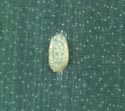Background
The Leek Moth (Acrolepiopsis assectella) larva is specialized to feed on the leaves of various plants belonging to the genus Allium. In Asia and the U.K the Leek Moth is considered a minor pest. However, in continental Europe it has caused considerable damage, particularly to leeks. It was first detected in Canada in 1993 in the National Capital Region (Ottawa-Hull) where a local population is now established (J.-F. Landry, in L. Handfield.1997. Liste des Lepidopteres du Quebec et du Labrador. Fabreries Supplement 7.).
Hosts
A variety of species in the Lily family, Liliaceae serve as hosts. Leek (Allium porrum) is the preferred host. Other hosts include, onion (Allium cepa var. cepa), chives (Allium schoenoprasum), garlic (Allium sativum) and Shallot (Allium cepa var. aggregatum).
Distribution
- Africa, Asia, Europe, North America: Canada (Ontario, Quebec, Prince Edward Island, New Brunswick)
Biology
Leek moth adults overwinter in plant debris emerging in April when the temperature reaches 9.5°C. Mating taking place 24 hours after emergence. Females are generally considered to be monogamous and live for about 23 days. The adults are nocturnal with flights and mating restricted to the hours of darkness, flights rarely occurs during the day. On average there are three generations per year. Female moths lay eggs singly on the host, mostly on the lower leaf surface, and usually near the base of the plant. The eggs hatch in 4 to 6 days in the spring and 8 to 11 days in the fall. Solitary larvae begin mining the leaves upon hatching, only if their mines coalesce do they become gregarious. On leek, they prefer to feed on the youngest leaves, but can consume leaves more than two months old. They bore through the folded leaves to the centre of the plant, causing a series of pinholes and feeding on the inner leaves. On onion, they feed inside the hollow leaves. Occasionally, larvae may attack reproductive parts of the host plant but usually avoid the flowers. The flowers contain a saponin compound that inhibits the growth of the larvae. There are five larval instars, which last about 11-23 days. Pupation occurs mainly on the food plant but can also occur on the soil or neighbouring plants, or among plant debris. In the field, the pupal stage lasts about three weeks, or it may overwinter.
Detection & Identification
Symptoms
- Under field conditions the damage is more prevalent at the field perimeter than toward the centre. Symptoms on younger plants in early summer include mines and perforations. The larvae may attack all parts of the plant except for the flowers. The larvae and pupae are often hidden in Allium tops in the new growth near the crown. Visual inspection for larval damage is most effective for plants with very small tops. It is common to find both old and recent feeding damage on a plant.
Identification
- The adults have a wing span of approximately 15 mm. The forewings are pale brown to black in colour. The forewing has a large triangular white mark with smaller white markings. The hindwings are pale gray to light black in colour. The egg is white in colour, oval and about 0.4 mm in diameter. The larvae are yellowish green in colour with gray-brown patches, possessing a yellowish brown head, mature larvae are 13 to 14 mm in length. The 5th instar larvae emerge from the leaves to pupate, the pupal case is reddish-brown in colour. The cocoon is white in colour and is composed of a loose net-like structure. Most cocoons are found on the leaves but they can also be found on the ground and on neighbouring plants.
Text: Plant Health Surveillance Unit
Photo Credits: Fig. 1-2 Institut National de la Recherche Agronomique, 147, rue de l'Université, 75338 Paris Cedex 07 France, Fig. 3-9 Dr. J-F. Landry, Eastern Cereal and Oilseeds Research Centre, Agriculture and Agri-Food Canada, Ottawa.








